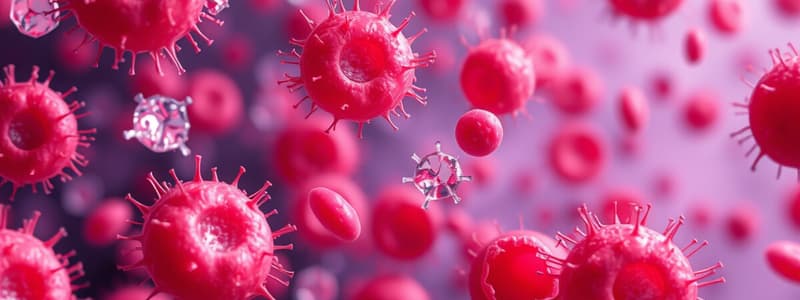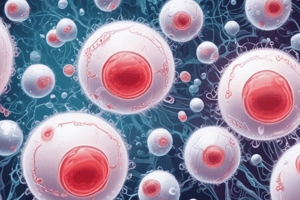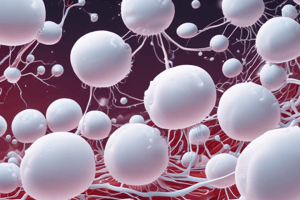Podcast
Questions and Answers
What are the three types of lymphocytes?
What are the three types of lymphocytes?
- B cells, T cells, NK cells (correct)
- M cells, T cells, NK cells
- B cells, A cells, NK cells
- B cells, T cells, C cells
What is the primary function of platelets?
What is the primary function of platelets?
- Fight infections
- Promote vascular spasm and blood clotting (correct)
- Transport oxygen
- Produce hormones
Where does the heart rest in the body?
Where does the heart rest in the body?
- Above the lungs
- On the diaphragm near the midline of the thoracic cavity (correct)
- In the abdominal cavity
- In the pelvic cavity
What is the average mass of the heart in adult males?
What is the average mass of the heart in adult males?
What component of blood protects against disease?
What component of blood protects against disease?
What is the long axis measurement of the heart?
What is the long axis measurement of the heart?
Which part of the heart is described as the pointed tip?
Which part of the heart is described as the pointed tip?
How many cm deep is the heart from anterior to posterior?
How many cm deep is the heart from anterior to posterior?
What is primarily responsible for blood clotting?
What is primarily responsible for blood clotting?
What is the primary function of capillaries?
What is the primary function of capillaries?
Which of the following arteries is classified as an elastic artery?
Which of the following arteries is classified as an elastic artery?
What is the role of valves in veins?
What is the role of valves in veins?
How do muscular venules differ from postcapillary venules?
How do muscular venules differ from postcapillary venules?
What is meant by the term 'resistance vessel' in relation to elastic arteries?
What is meant by the term 'resistance vessel' in relation to elastic arteries?
Which of the following best describes the specific size of capillaries?
Which of the following best describes the specific size of capillaries?
What is the remnant of the ductus arteriosus called after it closes?
What is the remnant of the ductus arteriosus called after it closes?
Which heart chamber is the thickest?
Which heart chamber is the thickest?
Which valve is located between the right atrium and the right ventricle?
Which valve is located between the right atrium and the right ventricle?
What type of valve is the left atrioventricular valve considered to be?
What type of valve is the left atrioventricular valve considered to be?
What structure connects the pulmonary trunk and the aortic arch?
What structure connects the pulmonary trunk and the aortic arch?
Which structure receives blood from the lungs?
Which structure receives blood from the lungs?
What feature is present in the left ventricle for anchoring the valve cusps?
What feature is present in the left ventricle for anchoring the valve cusps?
What is the primary function of the atrioventricular valves?
What is the primary function of the atrioventricular valves?
How many pulmonary veins are there that carry blood from the lungs to the heart?
How many pulmonary veins are there that carry blood from the lungs to the heart?
Which part of the heart's left atrium has a smooth internal wall?
Which part of the heart's left atrium has a smooth internal wall?
What is the function of the interatrial septum?
What is the function of the interatrial septum?
What is the fossa ovalis a remnant of?
What is the fossa ovalis a remnant of?
Which valve is also known as the tricuspid valve?
Which valve is also known as the tricuspid valve?
What separates the right ventricle from the left ventricle?
What separates the right ventricle from the left ventricle?
What structure shunts blood from the pulmonary trunk into the aorta during fetal life?
What structure shunts blood from the pulmonary trunk into the aorta during fetal life?
What type of tissue composes the heart valves?
What type of tissue composes the heart valves?
What structure is located within the right atrium?
What structure is located within the right atrium?
Which blood vessel carries blood to the heart wall?
Which blood vessel carries blood to the heart wall?
What does the aortic arch carry blood to?
What does the aortic arch carry blood to?
What is the role of papillary muscles in the heart?
What is the role of papillary muscles in the heart?
What is the primary function of the sinoatrial (SA) node?
What is the primary function of the sinoatrial (SA) node?
What percentage of cardiac cells are self-excitable?
What percentage of cardiac cells are self-excitable?
What best describes depolarization in cardiac cells?
What best describes depolarization in cardiac cells?
Which structure in the heart is responsible for the drainage of the right ventricle directly into the right atrium?
Which structure in the heart is responsible for the drainage of the right ventricle directly into the right atrium?
What is meant by the term 'excitable' in the context of cardiac cells?
What is meant by the term 'excitable' in the context of cardiac cells?
What aspect of cardiac cells allows them to contract in a continuous way?
What aspect of cardiac cells allows them to contract in a continuous way?
What kind of system is the intrinsic conduction system of the heart?
What kind of system is the intrinsic conduction system of the heart?
Where is the sinoatrial (SA) node located?
Where is the sinoatrial (SA) node located?
Which of the following best describes the relationship between the sinoatrial (SA) node and the rest of the cardiac cells?
Which of the following best describes the relationship between the sinoatrial (SA) node and the rest of the cardiac cells?
What role does the anterior cardiac vein play in the heart's anatomy?
What role does the anterior cardiac vein play in the heart's anatomy?
Flashcards are hidden until you start studying
Study Notes
Lymphocytes and Blood Protection
- Lymphocytes include B cells, T cells, and natural killer (NK) cells.
- Blood can clot, preventing excessive loss after injury.
- White blood cells engage in phagocytosis to protect against diseases.
- Platelets are cell fragments lacking a nucleus that release chemicals to aid blood clotting and vascular spasm.
Anatomy of the Heart
- The heart is approximately the size of a closed fist and rests on the diaphragm near the thoracic cavity's midline.
- Heart dimensions:
- Long axis: 12 cm (5 in)
- Width: 9 cm (3.5 in)
- Depth: 6 cm (2.5 in)
- Average mass: 250 g (8 oz) in females; 300 g (10 oz) in males.
- The heart is located in the mediastinum, with two-thirds of its mass to the left of the midline.
Heart Structure
- Apex: The pointed tip formed by the left ventricle.
- Interatrial septum separates the right and left atria.
- Fossa ovalis: A depression in the interatrial septum, a remnant from fetal development.
- Right atrioventricular (tricuspid) valve: Controls blood flow from right atrium to right ventricle.
Cardiac Valves
- Heart valves are made of dense connective tissue covered by endocardium.
- Left atrium receives blood from the lungs via four pulmonary veins.
- Blood flows from the left atrium to the left ventricle through the left atrioventricular valve (bicuspid/mitral valve).
- The left ventricle is the thickest heart chamber with an average thickness of 10-15 mm (0.4-0.6 in).
Specialized Cardiac Tissues
- Myocytes are responsible for heart contraction and include trabeculae carneae and chordae tendineae.
- Excitability allows cardiac cells to respond to stimuli and initiate action potentials.
Heart Conduction System
- The intrinsic conduction system consists of self-excitable cardiac cells (1% of total).
- The sinoatrial (SA) node, or pacemaker, is located in the right atrium wall, synchronizing heart contractions.
Blood Vessel Overview
- Elastic (conducting) arteries, such as the aorta, are key to regulating blood flow and act as pressure reservoirs.
- Postcapillary venules receive blood from capillaries, while muscular venules have thicker walls for substance exchange.
- Capillaries connect arterial outflow to venous return and facilitate the exchange of substances.
Veins
- Veins have thin walls and diameters ranging from 0.5 mm in small veins to 3 cm in major venae cava.
- Many veins, especially in limbs, contain valves to prevent backflow, aiding venous return.
Studying That Suits You
Use AI to generate personalized quizzes and flashcards to suit your learning preferences.




